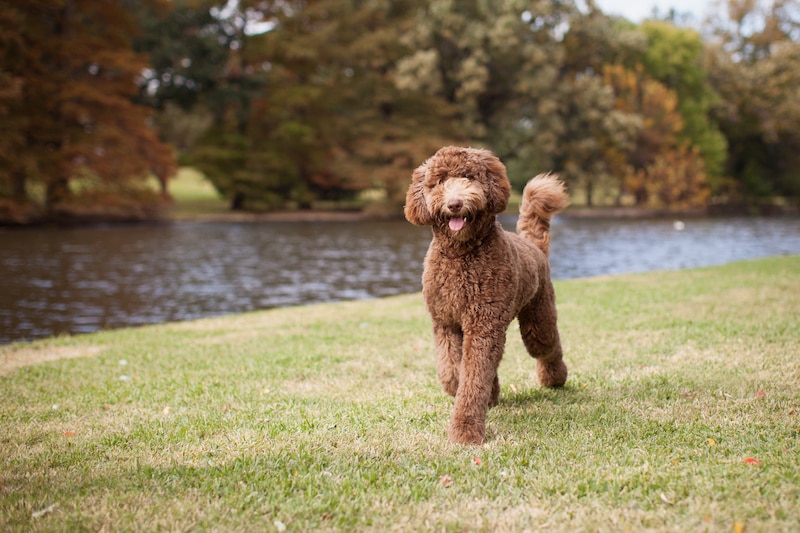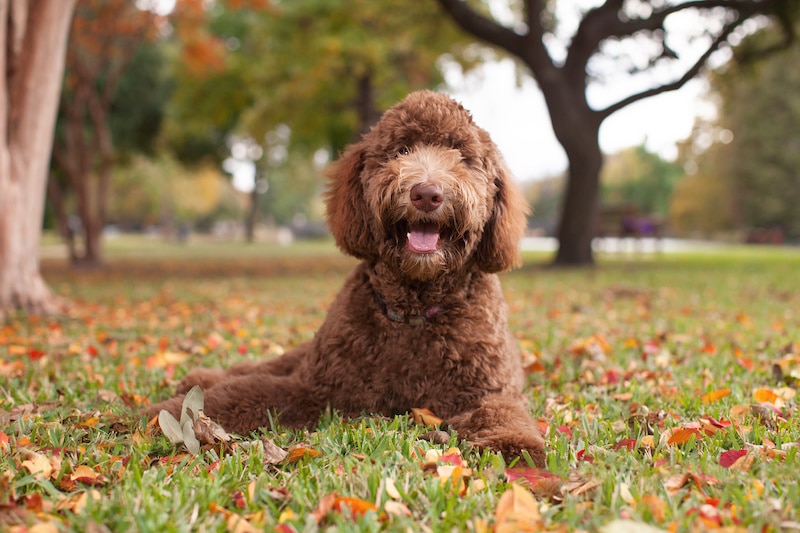The Labradoodle is a mid-sized dog that’s bred by mixing a Poodle with a Labrador Retriever. The result is a cute dog with a shaggy, curly coat that’s much beloved. You might have always wanted a Labradoodle yourself, but there’s one thing you’re curious about.
How much does the Labradoodle shed?
Most Labradoodles are very low-shedding dogs, thanks to their Poodle ancestry. However, those with more Labrador than Poodle in their genes will shed more frequently. As a result, these Doodles will have a hairy coat rather than one that’s fleecy or wooly.
There’s lots more to learn about the Labradoodle and its shedding behaviors in this article, so make sure you keep reading. I’ll also talk about whether the Doodle is hypoallergenic as well as provide grooming tips.
Labradoodle Shedding
Fluffy, shaggy, and adorable, you can add one more adjective to the list when describing the Labradoodle: low-shedding.
Well, usually.
Like all offspring, Labradoodles inherit traits from their mothers and their fathers. However, since their parents are two different dog breeds, the Doodle’s traits are a mixed bag.
If your Labradoodle adopts its traits primarily from its Poodle side, this is good news for you. Poodles are one of the lowest-shedding dog breeds around.
There are three reasons for this. First, the Poodle is single-coated. Second, the fluffy, wavy texture of its fur can also trap the loose hair it sheds so it doesn’t make a mess all over the house. And the third reason Poodles shed little is that their hair growth cycle is slow.
All dogs undergo a hair growth cycle that has four stages. These are anagen, catagen, telogen, and exogen.
The anagen phase is for growth. A dog’s hair will grow to whatever length that genetics determine. The second phase, catagen, stops hair growth at that prescribed point.
The telogen stage is a brief phase of rest in which the hair doesn’t come out, but it soon will. Finally, it’s during the exogen stage when a dog sheds its fur. Then the cycle renews afresh.
Some dog breeds spend longer in the first two or three stages of their hair growth cycle than in the fourth. This causes the dogs to shed infrequently, as is the case with the Poodle.
If your Labradoodle has wooly or fleecy fur, then it’s more Poodle than Labrador Retriever. Your dog should shed minimally, which is a relief.
Labradoodles are double-coated, yet even during seasonal shedding periods, your Doodle will retain most of its hair. The rest of the year, your dog will shed some of its fur through regular hair cycle turnover, but nothing major.
Let’s talk about the other parent of the Labradoodle, the Labrador Retriever.
If the Poodle is regarded as one of the lowest-shedding breeds, the Lab is among the highest.
They’re double-coated dogs (which is where the Labradoodle gets it from), but Labs will blow their coat twice a year. This means your Labrador Retriever will shed its fur ahead of the winter and then again in the summer.
The point of the cold-weather shedding is to bulk up the dog’s coat for the winter. In the summer, a Labrador Retriever sheds to stay cool and light all summer long.
The short fur of a Labrador Retriever also works against it in keeping the breed low-shedding. Since its fur is short, that means the hair goes through the four hair growth stages quickly.
Before you know it, your Lab’s coat has moved on to the exogen phase, where its hair comes out. As you know, its hair growth cycle would then start again.
In the meantime, a longer-haired dog breed might go through all four hair cycle stages one time while the Lab does the same several times.
Labradoodles that are a lot like their Lab parent might not have short fur, but they’ll shed more frequently all the same.
Grooming Your Labradoodle
Regardless of whether your Labradoodle is a heavy or light shedder, grooming the dog will still have to be a regular part of its care routine.
Three to four times per week, brush your Doodle with a slicker brush. Comb their entire body, but as you go through areas like behind their ears, their armpits, their chest, and under their neck, pay special attention.
These areas are the ones that are the likeliest to get tangled and matted up. If you do spot a mat, you can use a detangling brush to pull it loose. Go gently as you work. The location of the mats is close to a Doodle’s skin, so brushing can be painful if you’re too rough or fast.
If the knots don’t want to come out with a detangling brush, try applying cornstarch on your Labradoodle’s knots and then brush them again. The cornstarch can help knots and mats detangle without pain for your dog.
To make sure you spot every potential mat, please part your Doodle’s fur as you brush them.
Then it’s time to start trimming. Although the Doodle’s fur can get shaggy, especially around its face, you can’t leave its facial fur to grow this way and that. So instead, with a pair of dog-grooming scissors, cut the hair away from their eyes.
A Labradoodle’s muzzle needs to be an inch in length under their jawbone all the way to their neck. This keeps their face cleaner when they eat and drier when they drink.
The length of a Doodle’s ear hair should be no greater than an inch below where their ear ends. If you let the hair get unruly here, it will become matted. Plus, you’re failing to meet breed standards for the Labradoodle.
The average coat length of a Doodle is two inches, although some dog owners let the dog’s fur grow twice that long. I don’t really recommend it, as that means you’ll have to brush your Labradoodle every day.
To maintain the dog’s lower half, trim their paws using an electric clipper. A #30 blade will allow you to shape the paws, so they’re round and appealing. The legs should be clipped as well, so the hair here is half an inch long.
A Doodle’s tail fur should be kept at a length of two to three inches on average so the fur can feather out. The dog’s tail can get very matted, so don’t let the hair grow uncontrolled here.
This pro grooming guide on YouTube will show you what a Labradoodle looks like when it conforms to breed standards.
Since the Labradoodle’s fur isn’t particularly fast-growing, you can do all this trimming every six weeks or so, maybe eight weeks. Of course, if maintaining breed standards for the Doodle is proving too hard to do at home, you can always bring your dog to a groomer.
You’ll have to bathe the Labradoodle more frequently than you trim, plunking your dog in the tub about once a month.
Recommended: Go here to see our top-rated dog hair blow dryers
Are Labradoodles Hypoallergenic?
If you really want a Labradoodle, but either you or someone in your household is allergic to dogs, then you may be wondering if Doodles are hypoallergenic.
This question has a complex answer, so allow me to break it down into two parts.
First, here’s the thing about hypoallergenic dogs: no dog is 100% hypoallergenic.
And the reason I say that is that when someone is allergic to canines, it’s not the dog’s fur that aggravates their allergy symptoms. Instead, it’s the dog’s dander, which is dead skin. And since all dogs have skin, none can be truly hypoallergenic.
Now, shedding does play a role in how hypoallergenic a dog is, to a degree. When a dog doesn’t shed much, the dead skin can’t travel as far, which means fewer days of misery for an allergy sufferer.
The size of a dog also influences whether they’re hypoallergenic. Smaller to mid-sized dogs have less surface area than large dogs, so they also shed less skin and hair.
As for the second part of the answer, a Labradoodle will be more hypoallergenic (or less so) depending on which dog breed it shares more ancestry with.
Poodles are regarded as one of the most hypoallergenic dogs. So if your Doodle takes after its Poodle parent, then it too will be a hypoallergenic canine, at least as much as any dog can be hypoallergenic.
However, Labrador Retrievers are not hypoallergenic in the slightest. So for the Doodles that are more Lab than Poodle, allergy sufferers will find it hard to get relief.
Recommended: Go here to see our top-rated dog hair blow dryers
Is a Labradoodle Right for You?
If you’re uncertain whether a Labradoodle is the right dog for you, allow me to help you make up your mind in this section.
The Labradoodle is thought to have existed at least as far back as 1955 when Donald Campbell coined the name. At the time, though, Doodles weren’t nearly as popular as they are today.
It wasn’t until the late 1980s that Doodles became service and guide dogs. Then, Wally Conron, a breeder from Australia, spread the good name of the Labradoodle down under.
Doodles are beloved for their vivid personalities. DogTime calls the Labradoodle affectionate, trainable, and intelligent.
Labradoodles are very high-energy and playful. They need daily exercise for at least 30 minutes but ideally 60 minutes. High-intensity exercise does not bother this breed in the slightest, so get ready to sweat.

Between the preference for lots of exercise and the breed’s size (Labradoodles are about 24 inches tall and can weigh up to 65 pounds), I would say that the Doodle isn’t the best choice for apartment dwellers or those with small homes.
If you really have your heart set on a Doodle, then take yours to the local park or another spacious outdoor area every day so they can romp around and tire themselves out.
Before you decide whether to adopt a Labradoodle, you should know this breed is prone to health issues. A type of bleeding disorder known as von Willebrand’s disease is common of the breed, as is elbow and hip dysplasia.
These health issues are inherited from the Doodle’s Labrador Retriever and Poodle parents. Of course, every dog has health issues of some kind, but Labradoodles are especially known for their health defects.
By selecting a high-quality breeder, you can ensure you bring home a healthy Doodle.
How will your Labradoodle acclimate with the family? Doodles can befriend other dogs in the house with some socialization and time. They’re also kind around cats.
Doodles like children as well, so they’re a great family companion all around.
Bottom Line
Labradoodles are mid-sized dogs that are the result of crossbreeding between Poodles and Labrador Retrievers. Therefore, their shedding rate might be higher or lower depending on which parent they share more DNA with.
Doodles, if they’re low-shedding, are hypoallergenic. This breed also gets along well with human and non-human members of the family alike.
However, Labradoodles need a lot of vigorous exercise every day, so they’re not for everyone. And due to its origins, the breed is also likely to develop certain health conditions unless you choose a reputable breeder.
Either way, a Labradoodle is certainly a four-legged friend to consider bringing home with its big heart, bold personality, and adorable face!













Please note: By submitting a comment using the above comment form, you confirm that you agree with the storage and handling of your data by this site as detailed in our Privacy Policy.